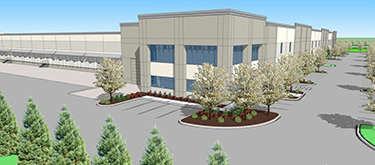|
Subscribe / Renew |
|
|
Contact Us |
|
| ► Subscribe to our Free Weekly Newsletter | |
| home | Welcome, sign in or click here to subscribe. | login |
Real Estate
| |
 |
February 23, 2017
Retailers, shippers push demand for industrial space
Colliers International

McGregor
|

Condon
|
We have been in industrial commercial real estate for over 13 years, focusing solely on the Puget Sound region with an emphasis on capital markets and institutional leasing. During this time, we have seen Seattle evolve and become one of the top markets in the country to own industrial buildings.
Over the past 13 years, we have seen our market weave through three distinctly different cycles: first a construction boom, then a downturn, and now a period of growth and acceleration.
From 2005 to early 2008, the Puget Sound market experienced its most significant construction activity in the industrial sector. This was followed by a downturn that started to recover in 2011, being one of the quickest markets in the country to recover.
Our current cycle has been extremely robust. The market was recovering nicely from 2011 through 2014, with gradual rent growth and activity, and then in the summer of 2015 activity increased to a level we have never seen. Tenant demand was at an all-time high, creating competition for vacant spaces and the level of tenant demand has continued at a very strong pace.

The recent growth cycle has been responsible for approximately 16 percent rent increases year over year, along with the Puget Sound region boasting one of lowest vacancy rates in the country. This significant rent growth and record setting compressed vacancy rate of 2.6 percent is a result of two related facts: delays in developments and historical demand.
Challenges to build
Due to the complexities involved in bringing the development sites through the construction process, projects are taking longer to complete. Today’s Class A sites were yesterday’s Class B opportunities.
Yesterday’s sites were well located and typically raw industrial zoned land that had far less complications. Today, sites are often highly complex redevelopment opportunities that have much longer lead times, environmental conditions to work through, significant off-site improvements, access challenges and political hurdles.
A couple recent examples of this are the former Weyerhaeuser campus in Federal Way and Sumner Meadows golf course, slated to be two of the region’s key industrial development sites in the future. Both have undergone significant legal and political hurdles, delaying the construction process.
Secondly, absorption over the past two years has far outpaced supply due to the combination of massive new demand and delayed construction as outlined above. Companies in our region have been expanding their space needs, resulting in nearly 6 million square feet of positive absorption in 2016, which is nearly double the historic average. Growth seems to be hitting all sectors, however online retailing and shipping are the leaders pushing demand.
The impact that retail has on the industrial market has never been more relevant. Fulfillment centers, warehouses and distribution hubs are taking more and more space across the region. Over the last six weeks, we have seen UPS commit to over 1.2 million square feet of new space. Amazon has expanded into another 600,000 square feet and others are battling for the remaining vacancies.
The South Seattle market continues perform at an incredible level with a record low 1.4 percent vacancy rate, which has resulted in the greater Sodo area seeing the largest rent growth at nearly 30 percent year over year.
Because of its geographical constraints, the next wave of developments in the Seattle/Sodo area are making headlines across the country. Prologis’ announcement to construct a 580,000-square-foot multistory warehouse in the market is the first project of its kind in the country. Multistory warehouses are common in Asia and Europe, where large land sites are hard to come by and now Seattle is following suit. The building type is a flagship for the U.S. and the Seattle area is uniquely positioned for it due to the lack of land in the area.
Pre-leasing at 44%
Multistory warehouses are one sign of a booming industrial sector; another is pre-leasing. In the past, the Puget Sound rarely would see buildings get pre-leased (leased prior to the building being finished), yet today 44 percent of the 4.7 million square feet of projects under construction are pre-leased.
Historically, supply has led demand, resulting in newly constructed speculative buildings sitting vacant for long periods before leasing up. Today, it is not uncommon for landlords and developers to secure tenants during the construction process. For example, Prologis just secured UPS in its Port of Tacoma project, pre-leasing a 770,000-square-foot building that will be the largest speculative building constructed in the area since 2006.
DCT Industrial Trust also recently pre-leased a 240,000-square-foot project in Fife to Milgard Windows. In addition, DCT is rumored to be close to securing a tenant for its DCT Blair Logistics Center that was slated as a 1.2 million-square-foot facility.
This pre-leasing trend will likely stick around for a while. However, this cycle has already reached historic lengths and some developers are beginning to get nervous about how long economic expansion is possible or predictable. During the 2005-08 industrial expansion, some developers that built during 2008 were left with large buildings that sat vacant throughout that downturn. Developers will look to the future with caution as they remember the trials of the past and worry when the current prosperous cycle might end.
There is little evidence of any kind of a slowdown threatening the Puget Sound economy. Over the course of 2016, 12,800 construction jobs were added as construction spending hit a 10-year high. Growth remains robust with Amazon’s expansion adding 100,000 new jobs by 2018, with 60 percent of those jobs at the company’s fulfillment centers.
The industrial market has been enhanced with the 2015 Northwest Seaport Alliance, which merges the ports of Tacoma and Seattle. This will make up the fourth most active port system in the U.S. In anticipation for this developing alliance between ports, the Port of Tacoma has 4 million square feet under construction.
With such great news coming out of both job and industry growth, record low vacancies, and limited new supply and historic rent growth, where do we go from here? The Puget Sound Industrial market will continue to tighten as demand continues to challenge land restraints and slow the development process.
We expect that vacancy rates will continue to fall and rent growth will reach new heights. As we look to the future, landlords and developers are positioned well to capitalize on owning property in one of the most active markets in the country that shows no signs of slowing down.
Matt McGregor and Bill Condon are executive vice presidents with Colliers International. They specialize in the Puget Sound industrial real estate market representing institutional owners and large tenants.
Other Stories:
- Seattle area office market riding a strong tailwind
- Endless job growth fuels robust multifamily market
- Runstad Center molds tomorrow’s real estate leaders
- Mid-rise apartments go upscale to take on high-rises
- Survey: Vulcan Inc.
- Survey: Bosa Development
- Seattle real estate market faces 3 big risks
- IRG keeps the polish on former Weyerhaeuser gem
- Transferable development rights: Where’s the incentive?
- Preserving a neighborhood’s roots with thoughtful design
- Sleepless nights for hotel investing?
- Survey: Beacon Development Group
- Survey: Wright Runstad and Co.
- Survey: Seattle Housing Authority
- Survey: Skanska USA Commercial Development



